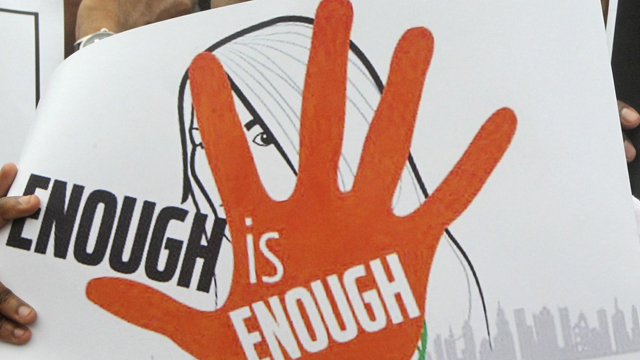There are a couple of disturbing realizations that one encounters, as one tries to analyze the mindset of the Indian society and the scarily increasing proportion of disturbing incidents against women that have crowded our conscience since the last decade.

It was only a few months back, when a survey by a leading market research firm concluded that Mumbai is the leading city in India when it comes to women safety. It could be fairly assumed that the participants in the survey were women, or else the basic agenda of the survey would be futile. One would wonder if the same survey is retaken this week, what results it would throw up. That Mumbai would lose its share of dominance is a foregone conclusion, but I do not believe it would lose its numero uno status as a safe city immediately.
What could be said of the grievous incident that occurred last week at the heart of the industrial hub in South Mumbai, that hasn’t been already said? Words cannot possibly even begin to assuage the scar that has been left in the psyche of that unfortunate but brave woman, perhaps for the rest of her life. As eminent columnist Shobhaa De laments, “it’s just another day for the people in this great country.” Pessimistic? Yes. Disturbing? You bet. Overstatement? Hardly. As this so-called great nation moves towards an attempted higher standard of living in the twenty first century, trying to bridge the gap between the developing and the developed nations, it has only regressed in the field of gender equality.
As someone who has lived in Mumbai for quite some time, one would know that the Maximum City has a great heart for everyone who moves his/her base in search of an identity in life. Work hard and you shall get rewarded, flounder and you shall perish. However, in all its rush, constant scavenging for a better morsel of life, its mechanism churning 24*7, one has never seen Mumbai lose its dignity in trying to help tripping souls, always stopping in between its maddening rush to pick them up. So as one sees all news channels and papers make this great deal about ‘Mumbai not being safe anymore’, ‘Mumbai losing its safe haven identity amongst women’, a question crosses the mind, is it always about the city? Do these incidents actually depict the law and order situation of the city, and its basic safety provisions for women and life in general? I’m afraid it doesn’t. For all the gruesome incidents occurring with an alarming regularity in the national capital, some disturbing incidents in the Eastern Capital of Kolkata and this one-off incident (I sincerely hope so) in the financial capital of the country, it always is about the people, irrespective of caste, community, creed or nationality.
There are a couple of disturbing realizations that one encounters, as one tries to analyze the mindset of the Indian society and the scarily increasing proportion of disturbing incidents against women that have crowded our conscience since the last decade. First, the parochial and patriarchal society in India never had a place reserved for women in the higher strata of society. The prehistoric belief about the female gender being restricted to the inner parlors of the households, in the kitchen and in the bed, has been instilled in our mindset for centuries. Unfortunately, our grandmothers and great grandmothers had not done much to resurrect the fortunes of the future generations of their gender, contributing to this wide-spread contagion by spinning yarns and preaching principles about the good and acceptable behavior of a woman as she grows up. So as women in the modern times try to break that stereotype and attemptto etch out a new identity for themselves, the Indian society would as an inherent nature, try to oppose this anomaly.
The general belief about women being weak, at least physically, leads to the thought process among men that they can be dominated by physical strength; and when this show of strength breaks barriers when opposed to, it turns into physical violence, at times sexual. Men are insecure beings, and the rise of a working woman, is often seen by them as a threat to the existing social structure where they held positions of superiority. Hence the lewd comments, the physical violence, the sexual harassments at home, parks and workplaces; outbursts of insecurity and frustration at the threat of a changing social structure.
Second, the long standing hypocritical stance of the Indian society as being traditional & pure has led to the belief that acts of amorous nature are dirty, unnatural to the human eye and taboo to discuss about, let alone display in public. Therefore adult magazines and graphic videos of the act are looked down upon as abhorrent objects and people indulging in them as a shame upon the family and society in general. Consequently, there is a huge underground market for pornographic material in the country. The acts performed in such videos, found in the secret cupboards and mobile phones of today’s youth, give an impression that women are nothing but sexual objects whose sole purpose for existence in this world is to satisfy the male desire, whim or fancy. This misinterpretation, coupled with suppressed sexual desire, clamped down by social taboo about premarital sex and healthy relationship between genders of opposite kind, gives rise to a perverse attitude towards women. One cannot justify the act of rape in any way whatsoever, but the mechanism or thought process working in the background cannot be hard to fathom. When the desire takes over, a man is nothing more than a dangerous beast which, in the reserves and game parks of Africa, is generally gunned down for the safety of others. Unfortunately, we stay in a civil society, and a human being cannot be treated like an animal (bear the irony of it!!!), and so following the procedure of law is the only feasible option.
Spreading of proper education and awareness among today’s generation is the basic necessity if one has to eradicate the perverse mentality directed towards women in India. In most of the cases observed so far, the culprits have been youths or men belonging to the lower social strata; school dropouts inhabiting the slums in the metros, who having had no exposure to proper education, have chosen menial labor or path of crime early in their lives to make a living. The existing measure of education in India is an utter hogwash and cannot be held as a benchmark; as merely being able to sign his/her own name on a piece of paper or completing four years of primary education cannot be assumed to have attained literacy. The foreign universities don’t hold a majority of our higher educational institutions as possessing any notable standard, so the state of education imparted in the primary schools can be guessed easily. The onus is with the Government and different social groups to impart proper education to the children from an early age on how to treat women and what exactly is gender equality. The parents would also have to take greater responsibilities in imparting the necessary words of wisdom to their kids and no topic should be kept taboo as we live in a digital age, and all information are available at the click of a mouse. Finally, the buck stops with the people we elect, as we have given them the right to manage our country, and they should be held accountable for every act of terror, treason or sexual violence that happens here.





